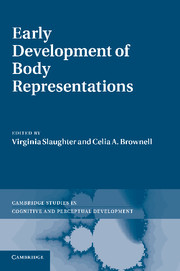
-
Select format
-
- Publisher:
- Cambridge University Press
- Publication date:
- October 2011
- October 2011
- ISBN:
- 9781139019484
- 9780521763820
- 9781107686496
- Dimensions:
- (228 x 152 mm)
- Weight & Pages:
- 0.6kg, 300 Pages
- Dimensions:
- (229 x 152 mm)
- Weight & Pages:
- 0.41kg, 300 Pages
- Subjects:
- Life Sciences, Developmental Psychology, Neurosciences, Psychology
You may already have access via personal or institutional login- Subjects:
- Life Sciences, Developmental Psychology, Neurosciences, Psychology
Book description
Because we engage with the world and each other through our bodies and bodily movements, being able to represent one's own and others' bodies is fundamental to human perception, cognition and behaviour. This edited book brings together, for the first time, developmental perspectives on the growth of body knowledge in infancy and early childhood and how it intersects with other aspects of perception and cognition. The book is organised into three sections addressing the bodily self, the bodies of others and integrating self and other. Topics include perception and representation of the human form, infant imitation, understanding biological motion, self-representation, intention understanding, action production and perception and children's human figure drawings. Each section includes chapters from leading international scholars drawn together by an expert commentary that highlights open questions and directions for future research.
Reviews
'I would wholeheartedly recommend Early Development of Body Representations to anyone interested in the specific problem of early body representation as well as in the larger problem of the development of body- and self-experience.'
Jack Demick Source: PsycCRITIQUES
Contents
Metrics
Full text views
Full text views help Loading metrics...
Loading metrics...
* Views captured on Cambridge Core between #date#. This data will be updated every 24 hours.
Usage data cannot currently be displayed.
Accessibility standard: Unknown
Why this information is here
This section outlines the accessibility features of this content - including support for screen readers, full keyboard navigation and high-contrast display options. This may not be relevant for you.
Accessibility Information
Accessibility compliance for the PDF of this book is currently unknown and may be updated in the future.


